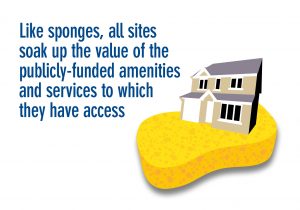
In the current tax regime land is permitted by society to be a private investment. Collecting AGR/LVT would partially or completely end this practice, which inflates land values far beyond their actual annual rental value (the amount someone would pay each year to monopolize a site’s natural and socially provided amenities.
When looking at the likely AGR liabilities it is therefore necessary to bear in mind that current site values are not a good guide. For example, prime farms today sell for about five times their productive value because governments choose to make them attractive investments with various tax breaks and access to subsidies.
This means that a proposed 1% AGR/LVT levy on prime agricultural land would not be £80 per acre (1% of today’s £8,000/acre) but £16 (1% of £1,600). A fundamental difference. And one which should also be borne in mind when predicting AGR liabilities for the owners of residential and urban sites.
‘Economic Rent’ is the surplus wealth of a country which remains after the costs of labour and capital have been met. Most of it is pocketed as unearned income by those who own land.
Because the government does not collect the economic rental surplus to pay for its necessary functions, it has to tax peoples’ earnings. This is detrimental to employment and trade. The collection of AGR by the government would have no detrimental effects on employment and trade but would instead encourage them by optimising the use of land.
The rental value of land is less variable than its market price which is influenced today by government interference, such as ‘help to buy’ schemes. The annual rental value of land is likely to remain constant unless it is increased by adjacent favourable developments or decreased by detrimental ones.
The market price of land is a useful guide to assess annual rental values because more data are available; but as the rental market for urban land increases adjustments can be made.
The annual rent of agricultural land with long term secure tenancies, for example, has traditionally been 5% of its market price (and the market price is 20 time its annual rent). But the current market price of agricultural land is almost 100 times its average annual rent because speculators, such as James Dyson, are buying land for the tax advantages.
‘Slipper farmers’ bid up farm prices, in turn attracting others to buy, resulting in the currently grossly inflated prices. The market price of urban land is similarly inflated by the favourable taxation of those who own landed property, especially that which is unused.
So whilst site values are a guide to the annual rental value which AGR/LVT would collect, the economic rental value of a site is its value above that of sites with no rental value because of their location rendering them capable only of providing subsistence: there is no surplus to provide rent after the costs of labour and capital have been met. The positive implications for the tax liabilities of peripheral communities is obvious.
